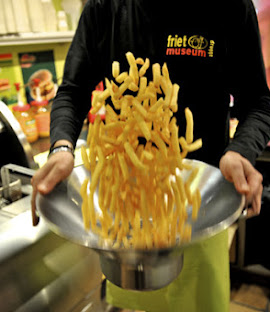
©
У понеділок, 28 квітня 2025 року, в центрі Брюсселя відбулося урочисте відкриття Музею картоплі фрі — нового культурного закладу, присвяченого одному з найвідоміших символів бельгійської гастрономії. Музей розташований поблизу знаменитої площі Гран-Плас, на вулиці, де стоїть статуя Хлопчика-дзюркунчика (Маннекен Піс). Загальна площа музею становить 900 м², і він пропонує відвідувачам інтерактивну, пізнавальну та смачну подорож у світ бельгійської фрі. Експозиція включає 1 645 об'єктів, серед яких — доісторичні артефакти, пов’язані з історією картоплі, старовинні фритюрниці та рідкісні видання ботанічних праць. Серед розваг — симулятор приготування фрі, гра з боротьби проти шкідників картоплі та джукбокс з піснями про фрі. Хоча в англомовному світі картоплю фрі називають "French fries", бельгійці наполягають на своєму авторстві. За легендою, у 1680 році мешканці долини річки Маас (Мозель) смажили дрібну рибу, але коли річка замерзла, вони почали смажити картоплю, нарізану у формі рибок. Ця традиція вважається початком історії фрі в Бельгії. Під час Першої світової війни американські солдати, скуштувавши фрі в Бельгії, назвали її "French fries", оскільки бельгійська армія спілкувалася французькою мовою. Наразі Бельгія залишається одним з провідних виробників та експортерів картоплі в Європі. Картопля становить 7,9% вартості сільськогосподарської продукції країни, що є одним з найвищих показників в ЄС. У 2018 році бельгійська переробна галузь досягла рекордного обсягу — понад 5 млн. т переробленої картоплі, що зробило Бельгію найбільшим експортером замороженої картоплі у світі.
On Monday, April 28, 2025, the grand opening of the Museum of French Fries took place in the heart of Brussels — a new cultural institution dedicated to one of the most iconic symbols of Belgian gastronomy. The museum is located near the famous Grand Place, on the street where the statue of the Manneken Pis (the "Little Peeing Boy") stands. Covering a total area of 900 m², it offers visitors an interactive, educational, and delicious journey into the world of Belgian fries. The exhibition features 1,645 items, including prehistoric artifacts related to the history of the potato, antique fryers, and rare editions of botanical works. Among the attractions are a fry-making simulator, a game about protecting potatoes from pests, and a jukebox with songs about fries. Although in the English-speaking world they are known as “French fries,” Belgians firmly claim authorship. According to legend, in 1680, residents of the Meuse River valley (also known as the Maas) used to fry small fish, but when the river froze in winter, they started frying potatoes cut in the shape of fish. This tradition is considered the beginning of the history of fries in Belgium. During World War I, American soldiers who tasted fries in Belgium called them "French fries" because the Belgian army communicated in French. Today, Belgium remains one of the leading producers and exporters of potatoes in Europe. Potatoes account for 7.9% of the country's total agricultural output — one of the highest rates in the EU. In 2018, Belgium’s processing industry reached a record volume of over 5 million tons of processed potatoes, making Belgium the world’s largest exporter of frozen potatoes.
1230